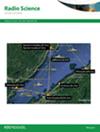Electron density profile derived from ionogram using ray tracing inversion method
IF 1.6
4区 地球科学
Q3 ASTRONOMY & ASTROPHYSICS
引用次数: 0
Abstract
The ionosonde is widely used for detecting electron density profiles below the F2 peak altitude. Extracting precise profiles from ionograms is crucial, as it serves as a significant data source for ionospheric studies and applications. In our study, we utilized the ray tracing profile inversion method (RTPI) to derive more realistic electron density profiles from the ionosonde observations. By comparing the electron density profiles inverted by RTPI method with and without geomagnetic field against the profiles observed by Incoherent Scatter Radar (ISR) plasma lines, we validated the high precision of the RTPI with magnetic field effect method. The results showed that the average height difference and average peak height difference between profiles inverted by RTPI and plasma line observations are less than 10 and 5 km, respectively. Additionally, we quantified the errors associated with the geomagnetic field effect. It would cause an ~8—10 km overestimation in true height and a ~ 10%—15% underestimation in electron density if the geomagnetic field effect is not considered. These errors induced by the magnetic field accumulate with the frequency of the radio waves. Moreover, we conducted a comparative analysis of simulated echo traces using profiles with different E-layer shapes. It was demonstrated that the key parameters of the bottom structure have a significant impact on ionogram retrieval, while the E-layer shape has negligible influence on inversion. Furthermore, we analyzed echo traces simulated using ray tracing with and without collision. The collision effect has weak effect on the delay of the radio waves.利用射线追踪反演法从电离图中得出电子密度曲线
电离层探测仪广泛用于探测 F2 峰值高度以下的电子密度剖面。从电离图中提取精确的剖面图至关重要,因为它是电离层研究和应用的重要数据源。在我们的研究中,我们利用射线追踪剖面反演法(RTPI)从电离层探测仪的观测数据中得出更真实的电子密度剖面。通过将 RTPI 方法反演的有地磁场和无地磁场的电子密度剖面与非相干散射雷达(ISR)等离子体线观测到的剖面进行比较,我们验证了带磁场效应方法的 RTPI 的高精度。结果表明,用 RTPI 反演的剖面与等离子体线观测的剖面之间的平均高度差和平均峰高差分别小于 10 公里和 5 公里。此外,我们还量化了与地磁场效应相关的误差。如果不考虑地磁场效应,真实高度会被高估约8-10千米,电子密度会被低估约10%-15%。这些由磁场引起的误差会随着无线电波频率的增加而累积。此外,我们还利用不同 E 层形状的剖面对模拟回波轨迹进行了比较分析。结果表明,海底结构的关键参数对电离图检索有重大影响,而 E 层形状对反演的影响可以忽略不计。此外,我们还分析了利用射线追踪模拟的有碰撞和无碰撞的回波轨迹。碰撞效应对无线电波延迟的影响较弱。
本文章由计算机程序翻译,如有差异,请以英文原文为准。
求助全文
约1分钟内获得全文
求助全文
来源期刊

Radio Science
工程技术-地球化学与地球物理
CiteScore
3.30
自引率
12.50%
发文量
112
审稿时长
1 months
期刊介绍:
Radio Science (RDS) publishes original scientific contributions on radio-frequency electromagnetic-propagation and its applications. Contributions covering measurement, modelling, prediction and forecasting techniques pertinent to fields and waves - including antennas, signals and systems, the terrestrial and space environment and radio propagation problems in radio astronomy - are welcome. Contributions may address propagation through, interaction with, and remote sensing of structures, geophysical media, plasmas, and materials, as well as the application of radio frequency electromagnetic techniques to remote sensing of the Earth and other bodies in the solar system.
 求助内容:
求助内容: 应助结果提醒方式:
应助结果提醒方式:


